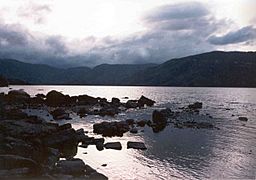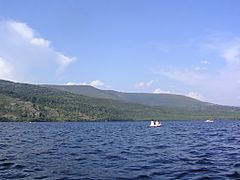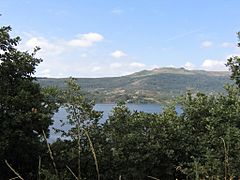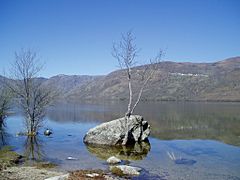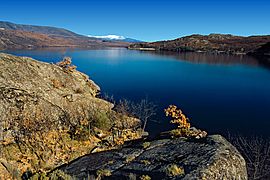Sanabria Lake Natural Park facts for kids
Quick facts for kids Sanabria Lake Natural Park |
|
|---|---|
|
IUCN Category V (Protected Landscape/Seascape)
|
|
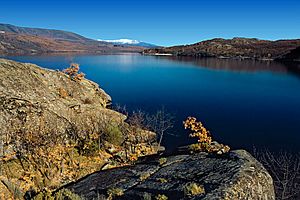 |
|
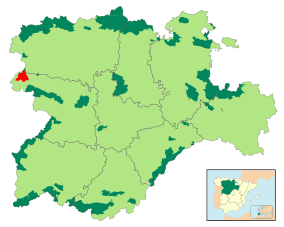
Locator map of Sanabria Lake Natural Park (red)
within the other parks in Castile and León |
|
| Location | Zamora Province, Castile and León, Spain |
| Nearest city | Puebla de Sanabria |
| Area | 22,365 ha |
| Established | October 27, 1978 |
| Visitors | 42,669 (in 2007) |
| Governing body | Junta de Castilla y León |
| Parque Natural Lago de Sanabria | |
The Sanabria Lake Natural Park is a special protected area in Spain. It is located around Sanabria Lake in the northwest part of the Zamora Province. This beautiful park is found in the mountains of Sierra Segundera and Sierra de la Cabrera.
The park covers a huge area of 22,365 hectares. To give you an idea, that's like more than 30,000 football fields! The land here goes from 997 meters (about 3,270 feet) near the lake up to 2,124 meters (about 6,970 feet) at the top of Peña Trevinca. The park includes parts of several towns like Galende, Cobreros, Trefacio, and Porto de Sanabria. It was officially created on October 27, 1978, to protect its amazing nature.
Contents
Sanabria Lake: A Glacial Wonder
The lake that gives the park its name is called Sanabria Lake. It is the biggest glacial lake in the whole Iberian Peninsula. A glacial lake is formed by the movement of huge ice sheets, called glaciers.
Sanabria Lake covers 318.7 hectares. It is also very deep, reaching 51 meters (about 167 feet) at its deepest point. In the mountains around the lake, you can find many smaller lakes. These tiny lakes and the deep valleys, called canyons, show how much the ancient glaciers shaped the land.
The park is full of streams and rivers. It also has many different types of plants. All of this makes the park a very beautiful and special place to visit.
Amazing Plants and Animals
One of the best things about Sanabria Lake Natural Park is its wide variety of living things. This is called great biodiversity. The park is home to many different kinds of plants and animals.
Forests and Plants
You will find forests mainly made of oak trees. Other trees like birch, alder, hazel, willow, ash, rowan, chestnut, holly, and yew also grow here. There are also large areas covered in scrubland, which are bushes like broom.
In the higher parts of the park, you might see heath instead of broom. Because of the many small glacial lakes, snow, and streams, you can even find peat bogs here. Peat bogs are rare in this part of the world. They are special wetlands where dead plant material builds up over time.
Wildlife and Their Homes
The park is a safe home for many different animals. You might spot a roe deer (Capreolus capreolus), which is a small type of deer. The park is also home to the wolf (Canis lupus).
Birds like the partridge (Perdix perdix) and the majestic golden eagle (Aquila chrysaetos) live here. In the water, you might see an otter (Lutra lutra) or a trout. All these animals have been protected by law since 1978.
Visiting the Park
If you want to learn more about the park, you can visit the Park Interpretation Centre. It is located in an old monastery called San Martín de Castañeda. This building used to belong to Cistercian monks a long time ago.
The centre has a permanent exhibition. It shows you all about the park's nature, its history, and the people who live there. You can see models, explanation panels, and videos. They explain how the land was formed, what people do in the park, and how they work to protect it.
From the centre, you get an amazing view of Sanabria Lake. In the summer, the centre is open every day for everyone to visit. During winter, it is open for groups from Monday to Friday. These groups can even have a guide to show them around the park. On Saturdays and Sundays in winter, the centre is open to everyone.
Gallery
See also
In Spanish: Parque natural Lago de Sanabria y sierras Segundera y de Porto para niños


